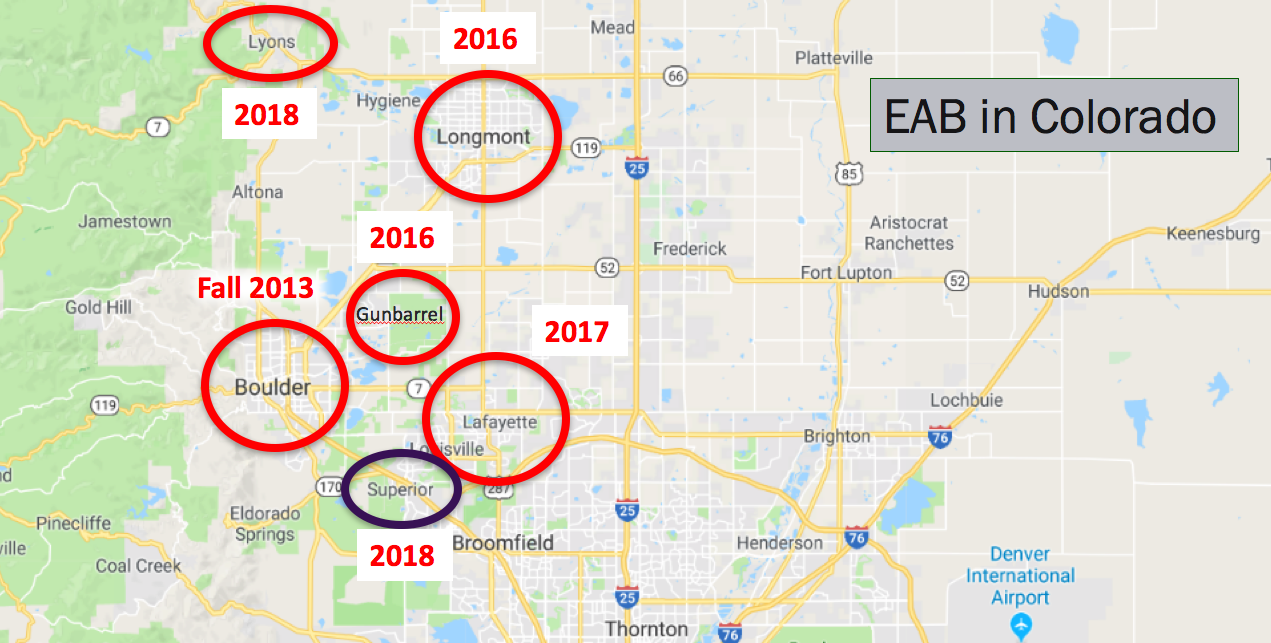In mid-June, the City of Denver confirmed the presence of the emerald ash borer (EAB)…

Emerald Ash Borer Detected in Superior, Colo.
SUPERIOR, Colo. – State officials have confirmed the presence of emerald ash borer (EAB), an invasive, highly destructive tree pest, in the Town of Superior in southeast Boulder County. This new detection is still just within a quarantine area established to try and prevent the human-assisted spread of EAB. However, it represents the fifth community with confirmation of EAB in Colorado outside the City of Boulder, where the pest was first detected in 2013.
An estimated 15 percent or more of all urban and community trees in Colorado are ash species susceptible to being killed by EAB – and a majority of these trees are on private land. There are 1.45 million ash trees in Metro Denver, and in the City and County of Denver specifically, one in six trees trees is an ash.
EAB attacks and kills both stressed and healthy ash trees and is so aggressive that trees typically die within two to four years after becoming infested. Additionally, it may be years before an ash tree shows signs of infestation, and by then it may be too late to save. That’s why the Denver City Forester is recommending the preemptive treatment of ash trees in the metro area.
The pest was confirmed in Boulder this week, shortly after Boulder County foresters identified a dead adult EAB on a trap the county had set – along with a dozen others in targeted areas – to detect for early infestation of the pest. This particular trap was located on public property along the Mayhoffer Singletree Trail, near the intersection of West Thomas and Third Avenue in Superior.
Since then, EAB symptoms have been confirmed in multiple nearby ash trees on private property, as experts from the interagency Colorado EAB Response Team – a group working to manage the spread and impacts of the pest – helps to assess the observable extent of EAB in the area.
Many Front Range municipalities also have set traps to try and potentially detect EAB as soon as possible after its arrival, including the Denver City Forester. The traps are designed as detection tools that lure in EAB adults using attractant odors and color schemes, and are coated in a sticky substance to capture individuals that come into contact with them.
It is unknown whether EAB arrived in Superior by natural spread or via accidental human transport, such as in firewood or other raw ash material. Populations of the insect are capable of spreading a half-mile each year on their own, and Superior is not far from other EAB detections in Lafayette and Boulder.
Many Front Range communities are managing for EAB before its arrival, including the Town and Superior and the City and County of Denver. Spurred by a complete tree inventory finalized in 2016, the Denver City Forester has planted 4,500 free trees on private property in preparation for the pest as part of the Be A Smart Ash program.
The Denver City Forester also plans to replace all small ash trees on city-maintained land, and has instituted a rigorous treatment schedule for some of the historic ash trees on city property. But perhaps most importantly, the tree census enables residents to use an interactive map to identify trees on their property to determine the presence of ash trees. Residents can also find information about EAB treatment options and request a free replacement tree to be planted in the right-of-way on their property.
EAB was first confirmed in Colorado in September 2013, in the City of Boulder. Since then, the pest has been confirmed in Gunbarrel, Longmont, Lafayette and Lyons – all within Boulder County and an established EAB Quarantine area. At this time, EAB has not been detected in Denver, nor anywhere in Colorado outside the county or quarantine. However, the pest is extremely difficult to detect when its numbers are low in an area.
